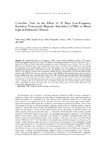Controlled trial on the effect of 10 days low-frequency repetitive transcranial magnetic stimulation (rTMS) on motor signs in Parkinson´s disease

Ver/
Use este enlace para citar
http://hdl.handle.net/2183/14505Coleccións
- Investigación (FCS) [1293]
Metadatos
Mostrar o rexistro completo do ítemTítulo
Controlled trial on the effect of 10 days low-frequency repetitive transcranial magnetic stimulation (rTMS) on motor signs in Parkinson´s diseaseData
2010-07-28Cita bibliográfica
Arias P, Vivas J, Grieve KL, Cudeiro J. Controlled trial on the effect of 10 days low-frequency repetitive transcranial magnetic stimulation (rTMS) on motor signs in Parkinson´s disease. Mov Disord. 2010;25(12):1830-38.
Resumo
[Abstract] We evaluated the effect of low-frequency rTMS
on motor signs in Parkinson’s disease (PD), under a doubleblind
placebo-controlled trial design. PD patients were randomly
assigned to received either real (n 5 9) or sham (n 5
9) rTMS for 10 days. Each session comprises two trains of
50 stimuli each delivered at 1 Hz and at 90% of daily rest
motor threshold using a large circular coil over the vertex.
The effect of the stimulation, delivered during the ON-period,
was evaluated during both ON and OFF periods. Tests were
carried out before and after the stimulation period, and again
1 week after. The effect of the stimulation was evaluated
through several gait variables (cadence, step amplitude, velocity,
the CVstride-time, and the turn time), hand dexterity,
and also the total and motor sections of the UPDRS. Only
the total and motor section of the UPDRS and the turn time
during gait were affected by the stimulation, the effect
appearing during either ON or OFF evaluation, and most
importantly, equally displayed in both real and sham group.
The rest of the variables were not influenced. We conclude
the protocol of stimulation used, different from most protocols
that apply larger amount of stimuli, but very similar to
some previously reported to have excellent results, has no
therapeutic value and should be abandoned. This contrasts
with the positive reported effects using higher frequency and
focal coils. Our work also reinforces the need for sham stimulation
when evaluating the therapeutic effect of
rTMS.
Palabras chave
TMS
Parkinson's disease
Therapy
Motor recovery
Parkinson's disease
Therapy
Motor recovery
Versión do editor
Dereitos
This is the peer reviewed version of the article which has been published in final form at Wiley. This article may be used for non-commercial purposes in accordance with Wiley Terms and Condiitons for self-archiving.





